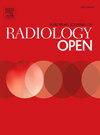多步急性脑卒中成像人工智能工具的性能:一项多中心诊断研究
IF 2.9
Q3 RADIOLOGY, NUCLEAR MEDICINE & MEDICAL IMAGING
引用次数: 0
摘要
目的:脑卒中仍是21世纪的主要疾病,目前已开发了多种人工智能(AI)工具来辅助脑卒中成像工作流程。本研究评估了fda批准和ce标记的人工智能设备的综合性能,该设备具有三个模块,用于检测脑出血(ICH)、识别大血管闭塞(LVO)和计算阿尔伯塔卒中计划早期CT评分(ASPECTS)。材料和方法回顾性收集2019年3月至2020年3月在La Timone和Nord University医院(法国马赛)获得的疑似卒中的非对比CT (NCCT)和/或计算机断层扫描血管造影(CTA)。人工智能工具china - head(阿维森纳)AI),处理数据标记ICH, LVO,并计算ASPECTS。结果与四位神经放射专家的真实评估进行比较,以计算诊断性能。结果405例患者(平均年龄64.9 ± 18.9 SD,女性52.6% %)共纳入373例NCCT和331例CTA。人工智能工具在NCCT上检测ICH的准确率为94.6 %[95 % CI: 91.8 %-96.7 %],在CTA上识别LVO的准确率为86.4 %[95 % CI: 82.2 %-89.9 %]。基于区域的ASPECTS分析的准确率为88.6% %[95 % CI: 87.8 %- 89.3% %],二分类的ASPECTS分类(ASPECTS≥6)的准确率为80.4 %。本研究证明了基于人工智能的脑卒中成像工具在ICH和LVO检测的诊断级联以及ASPECTS评分方面具有可靠的、逐步的性能。这种强大的多阶段评估支持其简化急性卒中分诊和决策的潜力。本文章由计算机程序翻译,如有差异,请以英文原文为准。
Performance of an artificial intelligence tool for multi-step acute stroke imaging: A multicenter diagnostic study
Objective
Several artificial intelligence (AI) tools have been developed to assist in the stroke imaging workflow, which remains a major disease of the 21st century. This study evaluated the combined performance of an FDA-cleared and CE-marked AI-based device with three modules designed to detect intracerebral hemorrhage (ICH), identify large vessel occlusion (LVO), and calculate Alberta Stroke Program Early CT Scores (ASPECTS).
Materials & methods
Non-contrast CT (NCCT) and/or computed tomography angiography (CTA) for suspicion of stroke acquired at La Timone and Nord University hospitals (Marseille, France) between March 2019 and March 2020 were retrospectively collected. The AI tool, CINA-HEAD (Avicenna.AI), processed the data to flag ICH, LVO, and calculate ASPECTS. The results were compared to ground truth evaluations by four expert neuroradiologists to compute diagnostic performances.
Results
A total of 373 NCCT and 331 CTA from 405 patients (mean age 64.9 ± 18.9 SD, 52.6 % female) were included. The AI tool achieved an accuracy of 94.6 % [95 % CI: 91.8 %-96.7 %] for ICH detection on NCCT and of 86.4 % [95 % CI: 82.2 %-89.9 %] for LVO identification on CTA. The region-based ASPECTS analysis yielded an accuracy of 88.6 % [95 % CI: 87.8 %-89.3 %] and the dichotomized ASPECTS classification (ASPECTS ≥ 6) achieved 80.4 % accuracy.
Conclusion
This study demonstrates the reliable, stepwise performance of an AI-based stroke imaging tool across the diagnostic cascade of ICH and LVO detection and ASPECTS scoring. Such robust multi-stage evaluation supports its potential for streamlining acute stroke triage and decision-making.
求助全文
通过发布文献求助,成功后即可免费获取论文全文。
去求助
来源期刊

European Journal of Radiology Open
Medicine-Radiology, Nuclear Medicine and Imaging
CiteScore
4.10
自引率
5.00%
发文量
55
审稿时长
51 days
 求助内容:
求助内容: 应助结果提醒方式:
应助结果提醒方式:


